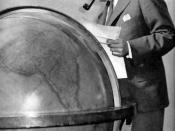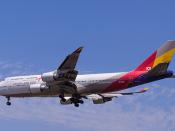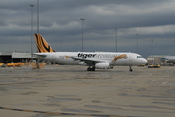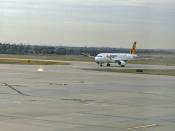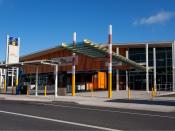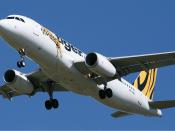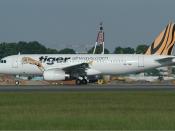IntroductionTiger Airways is internationally recognised as one of the Asia-Pacific's leading low fare carriers. The company had recognised that in this highly competitive market, any advantage gained by one airline over others will be short-lived, and ideas that are new will become commonplace in a matter of months. As such, Tiger Airways noted the importance of having to always stay at the forefront both in service and technology.
The intensity of competition in the airline industry and its profit potential are a function of Michael Porter's 'five forces' model of competition: the treats posed by new entrants, the power of suppliers, the power of buyers, product substitutes, and the intensity of rivalry among competitors.
Threats posed by new entrantsNew entrants to an industry typically bring to it new capacity, a desire to gain market share, and substantial resources (Wheelen and Hunger, 7th Ed, pg 61). The threat of new entrants largely depends on the barriers to entry - obstructions that make it difficult for a company to enter an industry (Wheelen and Hunger, 7th Ed, pg 62).
High entry barriers exist in some industries (e.g. shipbuilding) whereas other industries are very easy to enter (e.g. estate agency, restaurants). Key barriers to entry include the need to gain economies of scale quickly, the need to gain technology, large capital and investment requirements and potential saturation of the market.
Power of suppliersSuppliers are the businesses that supply materials & other products into the industry (Wheelen and Hunger, 7th Ed, pg 64). Suppliers can affect an industry through their ability to raise prices or reduce quantity of supply. The cost of items bought from suppliers (e.g. raw materials, components) can have a significant impact on a company's profitability. The bargaining power of suppliers affects the intensity of competition in an industry especially when there are a large numbers of suppliers, when there are only a few good substitute raw materials, or when the cost of switching raw materials is costly.
Power of buyersBuyers are the people or organisations that create demand in an industry (Wheelen and Hunger, 7th Ed, pg 64). When the buyers are concentrated or large, or buy in big volume, their bargaining power represents a force affecting the intensity of competition in an industry. Buyers affect an industry through their ability to force down prices, bargain for higher quality or more services, and play competitors against each other. The bargaining power of buyers is higher when the products being purchased are standard or undifferentiated. Whenever the bargaining power of buyer is substantial, rival companies may offer extended warranties or special services to gain customers loyalty.
Product substitutesSubstitutes are products that appear to be different but can satisfy the same need as another product (Wheelen and Hunger, 7th Ed, pg 63). In many industries, companies are in close competition with producers of substitute products in other industries. The presence of substitute products lowers the industry attractiveness and profitability because of the limited price levels. The competitive strength of substitutes is best measured by the market share those products obtain and those companies' plans for increased capacity and market penetration substitutes to aircrafts include sea and land transports which are much cheaper alternatives.
The intensity of rivalry among competitorsThere are many airline companies in the industry. As a result, intense rivalries are common. The companies are generally aware of competitors' actions, often choosing to respond to them. What Tiger Airways can do to counter the intense rivalry is to take competitive actions and competitive responses in efforts to be successful. The most important thing is of course to differentiate itself from competitors' offerings in ways that travellers and transportation companies value and in which Tiger Airways has a competitive advantage.
ConclusionTiger Airways has to continuously improve itself in order to stay competitive in the airline industry. In fact, the company is doing that very well. It has been fast in reacting to the changes in the industry environment, as evident from their current strategies of introducing a budget airline, cutting costs, focusing attention on business class travellers and implementing long haul flights. Following such moves, will Tiger Airways then be able to continue staying ahead of competitors and be ensured of its position as one of the world's leading carriers for many years to come? The answer remains to be seen.
ReferencesCoulter, Mary and Stephens P. Robbins (2007) Management 6thEdition, Prentice Hall InternationalDavid, Fred R. (2005), Strategic Management - Concepts and Cases 8th Edition. Prentice Hall InternationalHill, Charles and Gareth R. Jones (2006) Strategic management : an integrated approach 2nd Edition, Houghton MifflinHunger, J. David and Thomas L. Wheelen (2007) Essentials of strategic management, Prentice Hall InternationalKotler, Philip (2007) Marketing Management 11th Edition, Prentice Hall InternationalWheelen, Thomas L. and J David Hunger (2006) Strategic Management and Business Policy 7th Edition Prentice Hall International
